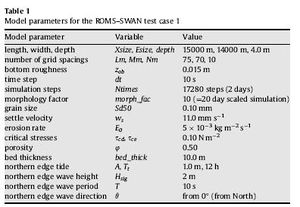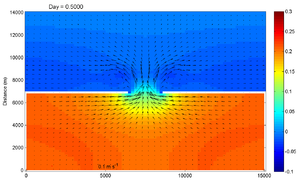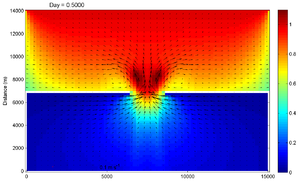INLET TEST CASE
This coupled example demonstrates the significance of wave-current coupling and includes ROMS coupled to SWAN. The application and methodology was originally developed and implemented as decribed in Warner, Perlin, and Skyllingstad (2008) "Using the Model Coupling Toolkit to couple earth system models", Environmental Modelling & Software, 23, p. 1240-1249.
The test case is a simple tidal inlet system, based on a rectangular basin domain that is 15 km wide by 14 km in length, with a uniform initial depth of 4 m. Model setup parameters are shown in the table below. The domain is separated into two regions. The seaward (top) region has northern, western, and eastern edges that are open with radiation boundary conditions. The backbarrier region (bottom) is enclosed with four walls and is connected to the seaward region through a 2 km wide inlet. The model is forced by a tide and waves. An oscillating water level is imposed on the northern edge with a tidal amplitude of 1 m. Waves are also imposed on the northern edge with a height of 1 m, directed to the south with a period of 10s.
Table 1. Model parameters for the ROMS-SWAN test case 1.
Below we provide a brief example of the model output.
cpp options: To compile this test case the user is required to activate: SWAN_COUPLING ?= on MPI ?= on
Figure 1. ROMS output of free surface and depth avg currents at t=0.5 days.
Figure 2. SWAN output of free surface and depth avg currents at t=0.5 days.


